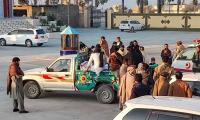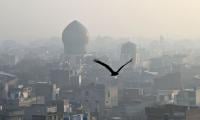LAHORE: As the sprawling metropolis of Karachi braces up to have its 28th mayor in 89 years, one can only hope in all the earnest that this 12th most populous city in the world regains its lost glory under an able leadership.
On June 29, 2022, Karachi Metropolitan Corporation’s budget of over Rs32.21 billion for the financial year 2022-23 was presented with Rs16.12 million in surplus.
History tells us that while the first local government elections in the history of Karachi, with a population of over 20 million today and an area of 3,780 square kilometres were held in November 1884.
A Municipal Committee started looking after its daily affairs in January 1885, some 15 years before British India’s first tramway system was constructed here, or just two years before the Port was formally established here in 1887 and around seven years after the city was connected by a railway line to the rest of India in 1878.
Widely believed to be the first municipality to collect state revenues in the Sub-Continent, the Karachi Municipal Committee used to levy House Tax on private property owners and ensure its prompt collection too.
According to Encyclopedia Britannica, Karachi had become the largest grain exporting port of the British Empire by 1914.
After World War I, manufacturing and service industries were installed, and by 1924, an aerodrome had been built, and Karachi became the main airport of entry to India.
The Encyclopedia Britannica writes: “Karachi was a small fishing village when a group of traders moved there in the early 18th century from the decaying port of Kharak Bandar nearby. The settlement expanded rapidly and was already of significance when it was captured in 1839 by the British, who annexed it in 1842. It then became an army headquarters for the British and also began to develop from a fishing village into the principal port for the Indus River region. In 1843 a river-steamer service was introduced between Karachi and Multan. Port facilities were improved from 1854 onward. In 1861, a railway was built from Karachi to Kotri. In 1864, direct telegraph communications were established with London and with the interior. With the opening of the Suez Canal in 1869, the importance of Karachi grew, and it became a full-fledged seaport. By 1873, it possessed an efficient and well-managed harbour.”
The city had its first elected mayor in 1933 when a local Parsi businessman-cum-politician, Jamshed Nusserwanjee Mehta (1886–1952), assumed charge along with 57 subordinate councillors.
From 1962 to 1979, Karachi was under an administrator system and hence without mayor’s office.
After Jamshed Nusserwanjee, still remembered as the “Maker of Modern Karachi,” Parsis, Muslims, Hindus and Christians all took turns as mayors of Karachi until 1947.
Jamshed’s family firm Messrs “Nusserwanji & Co” owned a retail shop at Saddar’s Elphinstone Street (now called Zaibunnisa Street), a salt factory, a tile factory, a flour mill, an ice factory and a large wholesale shop for home provisions and liquor.
The famous locality of Jamshed Quarters was developed by Nusserwanjee in 1922. He also laid the foundation of a hospital for leprosy patients near Manghopir, besides ensuring that the roads of Karachi were washed daily.
While Mayor Nusserwanjee had donated Rs135,000 for the construction of the famous Mama Parsi Girls’ High School on Bunder Road (now M A Jinnah Road) in Karachi some 105 years ago in 1918, one of his successors, Ardeshir Mama, had bestowed Rs300,000 for the same institution.
Soon after the First World War, Ardeshir Mama had owned the place where the Palace Hotel and Sheraton Hotel had stood for years.
Messrs Allah Bakhsh Gabol and Abdul Sattar Afghani had both served as Karachi’s mayors twice each.
Since Jamshed Nusserwanjee, following gentlemen have called shots as mayors of Karachi:
First Hindu Mayor Teakum Dass Vadhumull (1934-1935), the first-ever Muslim Mayor, patron of Karachi Children Society and one of the pivotal figures behind the establishment of Sindh Muslim College, Qazi Khuda Bukhsh (1935-1936), Ardeshir Mama (1936-1937), a noted Hindu business magnate, Durgadas Advani (1937-1938), a key member of Karachi Muslim League, Hatim Ali Alvi (1938-1939), renowned novelist Bapsi Sidhwa’s father-in-law, R K Sidhwa (1939-1940), respected philanthropist, educationist and an important character of Mahatma Gandhi’s historic “Non- Cooperation Movement,” Lalji Malhotra (1940-41), a member of the Bombay Legislative Council from Sindh constituency and a former Deputy Speaker of the then Sindh Assembly, Hashim Gazdar (1941-42), eminent Parsi historian and author Sohrab Katrak (1942-43), Shambo Nath Molraaj (1943-44), Karachi’s imposing business magnate, politician and philanthropist, Sir Abdullah Haroon’s son Yousaf Abdullah Haroon (1944-1945), Karachi’s only Catholic Mayor and a former president of a social and sports club “The Goa-Portuguese Association,” Manuel Misquita (1945-46), Wishramdas Dewan Das (1946-47), former Ambassador and a Provincial Minister, Hakeem Ahsan (1947-48), Quaid-i-Azam’s friend, biographer and a scion of Khoja-Ismaeli family, Ghulam Ali Alana (May 1948 to July 1948), owner of Karachi’s Lea Market, Safoora Goth, Abdullah Gabol Goth, Chutta Khan Goth, Gadap localities and politician Nabeel Gabol’s grandfather Allah Bakhsh Gabol’s first term (1951-1953), founder of the Habibullah Group of Companies that had stakes in coal mining, marble mining, chromite mining, fluorite mining, textile mills and sugar refineries, Habibullah Paracha (first term—1953 to 1954), Sir Abdullah Haroon’s second son and former Sindh Governor, Mahmoud A Haroon (1954-1955), the man who had announced construction of a fountain near the Quaid-i-Azam’s mausoleum in 1965, Malik Bagh Ali (1955-56), Siddique Wahab (May 1956 to December 1956), S M Taufiq (June 1958 to October 1958), Allah Bakhsh Gabol’s (second term—1961 to 1962), former MNA, once a member of the Congress Party’s youth wing and the man who spearheaded a campaign for the defunct Karachi Metropolitan Corporation’s right over motor-vehicle tax and property tax, Abdul Sattar Afghani (first term from November 1979 to 1983) and second term from 1983 to 1987), Farooq Sattar (1988 to 1992), Naimatullah Khan (2001 to 2005), Syed Mustafa Kamal (2005 to 2010) and Waseem Akhtar (2016 to 2020).
Captain Fahim Zaman Khan, who served as Karachi’s Administrator between August 10, 1998 and July 29, 2000, was granted pre-arrest bail by the Sindh High Court in March 2019 against a surety of Rs50,000 in a case where he was accused of abusing and misbehaving with police officials.
On August 24, 2016, Waseem Akhtar had defeated a six-party alliance, which was formed to contest against the dominant MQM. Some 308 directly and indirectly elected members of Union Committee of Karachi Municipal Corporation had voted for the mayor of Karachi over six years back.
And since August 30, 2020, we have seen administrators running the Karachi affairs at grass-root level.
While Dr Farooq Sattar remains the youngest-ever mayor of Karachi, having assumed reins of this office at the age of 28, it was under Abdul Sattar Afghani that the Karachi Water and Sewerage Board was established in 1983. It was also in 1983 that Afghani was handcuffed by police outside the Sindh Assembly building, when he was leading a protest of councillors. The elected council was then suspended and Saeed Ahmed Siddiqui was appointed as the administrator of Karachi Municipal Corporation.
Along with Naimatullah Khan, both hailing from Jamaat-e-Islami, Abdul Sattar Afghani is remembered as the most outstanding Mayor of Karachi.
Annals of history reveal that an Englishman, Sir Charles Bartle Frere, developed the Karachi harbour and laid down the railway line between Karachi and Kotri.
A book “Karachi during the British Era,” was authored by Behram Sohrab Rustomji and Sohrab Katrak, sheds enough light on the achievements of Charles Frere.
An article appearing in a local media house had read: “Roads were constructed, wells were dug and arrangements were made to illuminate roads. In 1859, the commission took responsibility of providing potable water to the city, and in 1870, Bunder Road (now M A Jinnah Road) was constructed to connect the city to the port. In 1883, the municipality laid 19-mile pipeline from Damloti wells to the city.”
It is noteworthy that the population of Karachi in 1941 was merely 386,655.
According to the aforementioned book penned down by Rustomji and Katrak, there were 180,199 Hindus in 1941; 162,447 were Muslims; 17,466 were Christians; 12,632 were scheduled castes; 5,835 were Sikhs; 3,214 were Jains; 3,700 were Parsis; 75 were Buddhists; 1,051 were Jews and 36 were “others.”
Video putatively shows that Bushra shifted from her vehicle to Gandapur’s placing her bag first and later herself
ECC directs Finance Division to furnish detailed report on Pension Scheme Amendment
Vawda says woman said she would march on D-Chowk but later ran away, while referring to Bushra Bibi
Establishment Division has issued official notifications of these postings and transfers
Minister says police was effectively held hostage by KP CM and Bushra Bibi during recent PTI’s protest
Maryam says she was really sorry for inconvenience suffered by people







